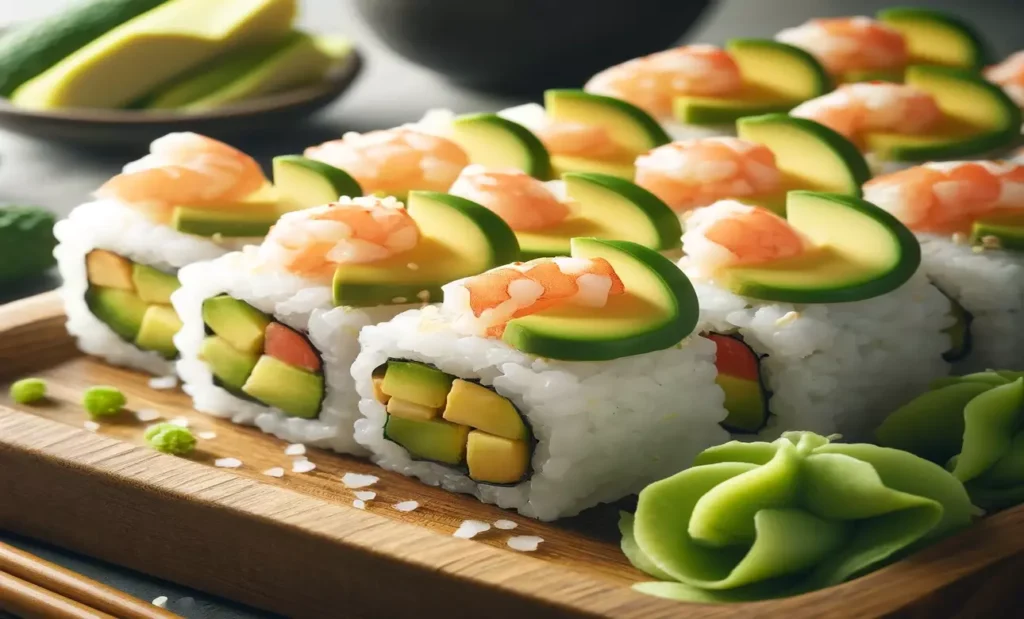Exploring Kanikama: A Delicious and Versatile Seafood Alternative

Kanikama, also known as imitation crab, is a popular seafood alternative enjoyed worldwide. It’s made to look and taste like crab meat but is made from fish. Kanikama is incorporated into a variety of dishes, ranging from sushi to salads. This guide will explore what kanikama is, its history, how it’s made, and its nutritional benefits. We will also provide some tasty recipes and tips for cooking with kanikama.
What is Kanikama?
Kanikama, or imitation crab, is a seafood product designed to mimic real crab meat’s taste, texture, and appearance. It is made from a type of white fish called surimi, which is processed and flavored to resemble a crab. Kanikama is often used in Japanese cuisine, especially in sushi and salads. However, it has also become popular in many other cuisines around the world.
History of Kanikama
Kanikama was invented in Japan during the 1970s as an affordable substitute for real crab meat. The idea was to create a product that offered the same taste and texture as crab but at a lower price. The word “kanikama” comes from the Japanese terms “kani,” meaning crab, and “kamaboko,” which describes a type of fish cake. Over the years, kanikama has gained popularity globally and is now a staple in many kitchens.
How is Kanikama Made?
Kanikama is made from surimi, a paste created from white fish like pollock or whiting. The fish is cleaned, deboned, and minced into a fine paste. This paste is mixed with other components like starch, sugar, salt, and seasonings to replicate the flavor and texture of crab meat. The mixture is then shaped into sticks or flakes and cooked to achieve the final product. Some kanikama varieties contain natural or artificial coloring to imitate the red-and-white look of crab meat.
Nutritional Benefits of Kanikama
Kanikama is a low-calorie, low-fat food that is high in protein. It offers vital nutrients, such as vitamins and minerals, including vitamin B12, selenium, and phosphorus. Although it contains fewer omega-3 fatty acids compared to actual crab, it can still be included in a healthy diet when consume in moderation. Here is a quick look at the nutritional content of kanikama (per 100 grams):
- Calories: 95
- Protein: 10 grams
- Fat: 1 gram
- Carbohydrates: 13 grams
- Fiber: 0 grams
Cooking with Kanikama
Kanikama is highly versatile and can be incorporated into many dishes. Here are some popular methods for cooking with kanikama:
Sushi and Sashimi
Kanikama is a popular ingredient in sushi rolls, such as California rolls. It can also be used in sashimi dishes as a topping or filling—the mild flavor of kanikama pairs well with other sushi ingredients like avocado, cucumber, and seaweed.
Salads
Kanikama adds a delicious seafood flavor to salads. You can mix it with greens, vegetables, and a light dressing for a healthy and refreshing meal. One popular dish is the kanikama salad, which includes kanikama, cucumber, and a creamy dressing.
Soups and Stews
Kanikama can be added to soups and stews for an extra burst of flavor. It works well in miso soup, seafood chowders, and hot pots. The texture of kanikama holds up well in broth, making it a great addition to these dishes.
Appetizers and Snacks
Kanikama can be used to make a variety of appetizers and snacks. It can be served as a dip with crackers, used in spring rolls, or even battered and fried for a crispy treat. Kanikama is also great in seafood cakes and croquettes.
Popular Kanikama Dishes Around the World
Kanikama has found its way into many different cuisines, adding its unique flavor and texture to a variety of dishes. Here are some popular kanikama dishes from around the world:
California Roll (USA)
The California roll is among the most popular sushi rolls in the United States. It usually features kanikama, avocado, and cucumber, all wrapped in sushi rice and seaweed. The roll is often garnished with sesame seeds or fish roe to enhance its texture and flavor. The creamy avocado and crisp cucumber complement the sweet and savory taste of the kanikama, making this a favorite among sushi lovers.
Kanikama Salad (Japan)
In Japan, kanikama is commonly used in salads. One popular dish is the kanikama salad, which features kanikama, thinly sliced cucumber, and a creamy dressing made from mayonnaise, rice vinegar, and a touch of sugar. This refreshing salad is great as a side dish or for a light meal. The crispness of the cucumber combined with the sweetness of the kanikama offers a delightful mix of flavors and textures.
Kani Su (Japan)
Kani Su is another Japanese dish that showcases the versatility of kanikama. This vinegared salad includes kanikama, cucumber, and wakame seaweed, all tossed together in a dressing made from rice vinegar, soy sauce, and sugar. The tangy dressing enhances the natural sweetness of the kanikama, while the cucumber and seaweed add a refreshing crunch. In Japanese cuisine, Kani Su is often served as an appetizer or a side dish.
Seafood Paella (Spain)
Paella is a traditional Spanish rice dish that usually includes a mix of seafood. While traditional recipes may call for fresh crab, kanikama can be used as a convenient and affordable alternative. In a seafood paella, kanikama can be combined with other seafood like shrimp, mussels, and clams, along with saffron-infused rice and vegetables. The kanikama imparts a gentle sweetness to the dish, enhancing the rich and savory tastes of the other ingredients.
Kanikama Sandwich (Global)
The kanikama sandwich is a simple yet delicious way to enjoy kanikama. This global favorite typically includes kanikama, lettuce, and mayonnaise, all sandwiched between slices of bread. The kanikama provides a mild and slightly sweet flavor that pairs well with the crisp lettuce and creamy mayonnaise. This sandwich is ideal for a quick lunch or a light snack, and it can be easily customized with additional ingredients like tomatoes, cucumbers, or cheese.
These popular kanikama dishes highlight the ingredient’s versatility and ability to enhance a variety of cuisines. Whether used in sushi, salads, or traditional rice dishes, kanikama adds a unique and delicious touch to any meal.
Comparing Kanikama with Real Crab
While kanikama is designed to mimic real crab, the two have some key differences. Real crab meat contains more omega-3 fatty acids and protein, which are useful for heart health and brain function. The flavor of real crab is also more distinct, often described as sweeter and more delicate compared to the milder taste of kanikama.
However, kanikama offers several advantages that make it a popular alternative. One of the main benefits is affordability. Real crab can be expensive and seasonal, while kanikama is available year-round at a fraction of the cost. This makes kanikama an accessible option for those who enjoy the taste of crab but are on a budget.
Nutritionally, kanikama is lower in calories and fat than real crab meat, making it a suitable choice for reducing caloric and fat intake. This can be especially helpful for individuals on weight management programs or those seeking to lower their cholesterol levels.
Additionally, kanikama is easy to use in a variety of dishes. Its uniform texture and taste make it a versatile ingredient suitable for a range of dishes, from sushi rolls to salads. It also has a longer shelf life than fresh crab, adding to its convenience.
In short, while real crab offers superior nutritional benefits and a more distinct flavor, kanikama provides an affordable, low-calorie, and versatile alternative that fits well into many culinary applications.
Buying and Storing Kanikama
When purchasing kanikama, it’s important to select products made with high-quality surimi and minimal additives. Quality kanikama should have a clean taste and firm texture, closely resembling real crab meat. Check the ingredient list for surimi as the main component, and avoid products with excessive artificial flavors or preservatives.
Kanikama is usually sold in vacuum-sealed packages or cans, which helps maintain its freshness and extends its shelf life. When choosing packaged kanikama, check the packaging for any signs of damage or leaks, as these may suggest spoilage.
After purchasing, kanikama should be stored in the refrigerator. After opening, it’s best to eat it within a few days to preserve its freshness and taste. If you plan to use only some of the kanikama, you can freeze the leftovers. To avoid freezer burn, tightly wrap the kanikama in aluminum foil or plastic wrap, then keep it in an airtight container or a freezer-safe zip-lock bag.
When ready to use the frozen kanikama, thaw it in the refrigerator overnight. To prevent bacterial growth, it’s best not to thaw at room temperature. Proper storage ensures that kanikama retains its quality, making it a convenient and tasty ingredient for various dishes whenever you need it.
Conclusion
Kanikama is a delicious and versatile seafood alternative that is convenient and affordable for adding a touch of seafood flavor to various dishes. Whether you’re making sushi, salads, soups, or snacks, kanikama is a fantastic ingredient to have in your kitchen. Its nutritional benefits and ease of preparation make it a great choice for anyone looking to enjoy the taste of crab without the cost.
Frequently Asked Questions
What is kanikama?
Kanikama, also known as imitation crab, is a seafood product made from surimi (white fish paste) and flavored to taste like crab meat.
Is kanikama healthy?
Yes, kanikama is low in calories and fat and high in protein. It offers vital vitamins and minerals, making it a healthy addition to your diet.
How is kanikama used in cooking?
Kanikama can be used in sushi, salads, soups, stews, appetizers, and snacks. It imparts a tasty seafood flavor to a variety of dishes.
Can kanikama be frozen?
Yes, you can freeze kanikama to prolong its shelf life. Ensure it is wrapped well to avoid freezer burn.
What are some popular dishes made with kanikama?
Some popular dishes include California rolls, kanikama salad, kani su, seafood paella, and kanikama sandwiches.
How does kanikama compare to real crab meat?
Although kanikama mimics the taste and texture of crab, genuine crab meat is richer in protein and omega-3 fatty acids. Kanikama is more affordable and lower in calories and fat.
Where can I buy kanikama?
Kanikama can be found in most grocery stores, typically in the seafood or refrigerated section. It is also available in Asian markets.






